A Postcard From Northern Haiti (2/22/2010)
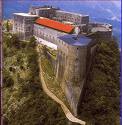 Hello from Cap Haitian, the chipped pearl of the Antilles. When I was a Peace Corps Volunteer in the Central Plateau, I would sometimes take Route National Three from Hinche to Cap for a long weekend. I never looked forward to the grueling trip, but I always looked forward to being in Cap. The beaches were (and still are) beautiful and this region is historically rich. It is here that Christopher Columbus landed and where he lost one of his ships. The Haitian slave rebellion began with a single Vodoun ceremony in Bois Cayman and ended with the battle of Vertieres. The Citadel looms from a mountain in the distance. While the city of Cap Haitian has changed, and not for the better, it is still good to be back in the north.
Hello from Cap Haitian, the chipped pearl of the Antilles. When I was a Peace Corps Volunteer in the Central Plateau, I would sometimes take Route National Three from Hinche to Cap for a long weekend. I never looked forward to the grueling trip, but I always looked forward to being in Cap. The beaches were (and still are) beautiful and this region is historically rich. It is here that Christopher Columbus landed and where he lost one of his ships. The Haitian slave rebellion began with a single Vodoun ceremony in Bois Cayman and ended with the battle of Vertieres. The Citadel looms from a mountain in the distance. While the city of Cap Haitian has changed, and not for the better, it is still good to be back in the north.
As the Port of Prince airport wasn’t open a week ago, I had to fly into the Dominican Republic. On the flight over to Puerta Plata, I could not help but feel a bit envious looking around at the plane full of tourists coming to Hispaniola not to convert but to cavort. I am not saying that I want the kind of tourists that were on the plane flooding Haiti, but we need the jobs that increased tourism would bring.
Whereas in Haiti our agricultural system is mainly subsistence, one only has to look out the airplane window to see the Dominican Republic’s highly organized yet exploitative agricultural system. During the three hour drive from Puerta Plata to the border, I saw only Haitians working in the rice fields. Many are paid little and are subject to human rights violations by the police, the military, and their employers. Sadly, more and more will try to cross illegaly into the Dominican Republic to find jobs which do not exist, or in the case of Port au Prince, no longer exist.
Once in Dajabon, the Dominican city directly across the border from Ounaminthe, I got a room in the Massacre Hotel, a somewhat sinister name for a hotel that was in reality fairly comfortable. The river takes its name from a conflict between French and Spanish colonizers battling for control of Hispaniola, but is all the more accurate given the October 1937 massacre of 30,000 Haitians by the Dominican Dicatator, Rafael Trujillo. Their corpses were unceremoniously thrown into the river that flows nearby. On Mondays and Fridays, there is a “Haitian Market” in Dajabon when Haitians are allowed to cross the border and sell their goods. The Haitian Market in Dajabon is bigger than many in Haiti, taking up several city blocks. Dajabon is building a large covered market, away from the center of town and closer to the border, but it is not yet finished.
After leaving Dajabon the next day, I made a quick stop in Ounaminthe. It is still the busy, bustling border town I remember albeit larger. An estimated 60,000 have fled Port au Prince to northern and northeast Haiti. Most are staying with host families. It is a testament to the Haitian character that these families, who were struggling before, have taken in most of the displaced In Ounaminthe, the vast majority are staying with friends and family while those who could not are sheltering in churches until they can find an alternative. For some that alternative will be the Dominican Republic.
Passing through Terrier Rouge, we began to see signs along the side of the road advertising horse meat. One of the cultural quirks of the north is that this is the only part of Haiti where people eat horse. Further along, we saw a Let Agogo outlet and a jatropha farm, both of which were not here the last time I was in Cap Haitian.
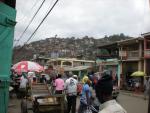 Pulling into Cap Haitian itself, I was alarmed at how degraded the infrastructure had become. Whereas the roads used to be quite good, they are now full of holes. Trash is piling up everywhere and blocking drainage canals. As a result many streets are flooded during heavy rains like we have been having here almost every day. Like all cities in Haiti, Cap Haitian continues to attract people from the countryside who are no longer able to make a living from agriculture. One can see that the city has become much more crowded and the infrastructure is not holding up.
Pulling into Cap Haitian itself, I was alarmed at how degraded the infrastructure had become. Whereas the roads used to be quite good, they are now full of holes. Trash is piling up everywhere and blocking drainage canals. As a result many streets are flooded during heavy rains like we have been having here almost every day. Like all cities in Haiti, Cap Haitian continues to attract people from the countryside who are no longer able to make a living from agriculture. One can see that the city has become much more crowded and the infrastructure is not holding up.
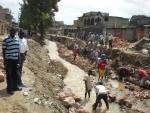 Some work is being done on the infrastructure. USAID is providing support to the International Organization for Migration (IOM) to implement cash-for-work programs to build canals, pave roads, and rehabilitate parks and government buildings. USAID is supporting CHF to do the same, and to help participants acquire skills. Cap Haitian clearly requires a massive public works program to provide jobs for those who were here before and those who have arrived as a result of the earthquake in Port au prince.
Some work is being done on the infrastructure. USAID is providing support to the International Organization for Migration (IOM) to implement cash-for-work programs to build canals, pave roads, and rehabilitate parks and government buildings. USAID is supporting CHF to do the same, and to help participants acquire skills. Cap Haitian clearly requires a massive public works program to provide jobs for those who were here before and those who have arrived as a result of the earthquake in Port au prince.
Cap Haitian is, for the most part, a calm and safe city. Life still happens at night. While I didn't have many contacts in this area anymore, I was able to make plenty just by walking around and saying hello to people at the small shops, klerin stands, and the town square. No point in staying in as you'll meet all kinds of people on the street.
This weekend, I was able to do something I had always wanted to do – visit Bois Cayman where the Haitian revolution began. First a tap tap to Morne Rouge and and then motorcycle taxi ride, only thirty minutes away from downtown Cap Haitian. There are no signs, but people can tell you how to get there. You will enter into a clearing where there is a small pavillion where Vodoun ceremonies are performed. This is in the general area where Boukman, a Vodoun Priest, held a Vodoun ceremony which was the spark that ignited the Haitian revolution.
Boukman was from Jamaica by his British “owner” to a French slaver for having tried to teach other slaves to read. That trade sealed the fate of the French who had exploited and abused wave after wave of kidnapped Africans who would eventually become Haitian. The ceremony itself was far from a pact with the devil. You have to understand the cruelty that was inflicted upon Haitians. They were abused, exploited, and quite literally worked to death by the French slavers, who would no doubt have considered themselves good Catholics. Passive resistance would not have freed Haitians from slavery, which is both crime and sin. To the contrary, this ceremony was the start of a long struggle for freedom, equality, and independence – one which continues today. The prayer he said the night of August 14, 1791 follows first in Kreyol and then in English:
Bondye ki fe soley, Ki klere nou anwo
Ki soulve lanme, Ki fe gwonde loray
Bondye zot tande, Kache nan yon nyaj
La li gade nou, Li we tout sa blan fe
Bondye blan mande crim, E pa nou vle byen fe
Men Dye la ki si bon, Odonnen nou vanjans
Li va kondwi bra nou, La ba nou assistans
Jete potre Dye blan, Ki swaf, dlo nan je
Koute la Libete ki pale na ke nou
God who made the sun, that shines down from above
That holds up the ocean, God who hears
Hiding in the clouds. From there, he watches us
He sees all that the whites do,
The white man’s god asks him to commit crimes.
But the god within us wants us to do good.
Our god, who is so good. He orders us to take revenge.
He will direct our arms. He will give us assistance.
Dispose of the image of the white man’s god.
Who is thirsty for the tears from our eyes.
Hear the Freedom that speaks from our hearts
Boukman did not live to see his prayer answered. He was killed by the French several months after the uprising began. They cut off his head and displayed it publicly in Ounaminthe in an effort to intimidate others from fighting for their freedom. Needless to say, it didn’t work. Haitians won their independence and their victory had regional repercussions. Haitians went on to fight in the American Revolution and provided Simon Bolivar with financial and military assistance that was instrumental in liberating Venezuela.
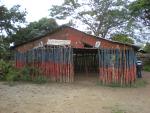 In the clearing, you can secure the services of a guide for twenty dollars or less. He will take you to the grotto where Boukman and other Neg Maroon (runaway slaves) would shelter. There is also a very old bridge that slaves were forced to walk across chained each to the other. If one would fall, all would perish. There are no signs, there are no organized tours – but there should be. I have the name and number of the Oungan who would like for more people to learn about this historic site and its relationship to Vodoun, Haitian, and World History. If you are in Cap Haitian, you can call Franse Jean Remond at (3) 465-40-46 or (3) 689-97-79. He speaks Kreyol and can probably get by in French, but you can have someone give him a call for you. Bois Cayman’s annual festival is from August 14-23. It would be a great time to go. I am hoping that a partnership can be reached between the hotels of Cap Haitian and the village of Bois Cayman so that more people can learn about Haitian history while creating much needed jobs.
In the clearing, you can secure the services of a guide for twenty dollars or less. He will take you to the grotto where Boukman and other Neg Maroon (runaway slaves) would shelter. There is also a very old bridge that slaves were forced to walk across chained each to the other. If one would fall, all would perish. There are no signs, there are no organized tours – but there should be. I have the name and number of the Oungan who would like for more people to learn about this historic site and its relationship to Vodoun, Haitian, and World History. If you are in Cap Haitian, you can call Franse Jean Remond at (3) 465-40-46 or (3) 689-97-79. He speaks Kreyol and can probably get by in French, but you can have someone give him a call for you. Bois Cayman’s annual festival is from August 14-23. It would be a great time to go. I am hoping that a partnership can be reached between the hotels of Cap Haitian and the village of Bois Cayman so that more people can learn about Haitian history while creating much needed jobs.
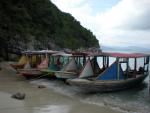 The next day Haitian friends and I headed out to the beaches, which are fantastic. I infinitely prefer them to the beaches of the Dominican Republic which are overdeveloped. On the road out to Labadee Beach there are some modest hotels on nice beaches such as Cormier Plage. Further on, at the base of the road which ends next to Labadee Beahc, you will find numerous water taxis that can take you to secluded hotels and beaches. This must be some of the last unspoiled waterfront property left in the Caribbean. The mountains are forested and the ocean is clear, clean and beautiful.
The next day Haitian friends and I headed out to the beaches, which are fantastic. I infinitely prefer them to the beaches of the Dominican Republic which are overdeveloped. On the road out to Labadee Beach there are some modest hotels on nice beaches such as Cormier Plage. Further on, at the base of the road which ends next to Labadee Beahc, you will find numerous water taxis that can take you to secluded hotels and beaches. This must be some of the last unspoiled waterfront property left in the Caribbean. The mountains are forested and the ocean is clear, clean and beautiful.
No need to stay in an over-priced and disappointing hotel in Cap itself – you can stay in Labadee Village, or farther on, at Norm’s Place, Habitation Labadee, or others. If you are interested in Labadee village itself, check out Kayanol, a small bed and breakfast that an entrepreneur in Labadee Village created. He has five furnished rooms as well as a bar and game room. I have no idea how he got the pool table to Labadee village. Anyways, the price is 25 dollars per night as compared to 90-100 dollars per night in Cap Haitian. You can get more information from Anol himself at kayanolvillage@hotmail.com or at (305) 303-5387.
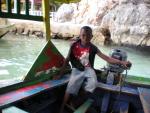 It will be cheaper and more enjoyable to stay out here although you might want to think twice if you will have to go to and from Cap Haitian each day. The road to these beaches is unfortunately not paved and the trip probably takes an hour our so depending on whether it has rained or not. We spent the day swimming, drinking Barbancourt, eating fresh seafood, and of course, listening to Kompa. A nice break considering Washington DC is still getting snow. A selfish part of me wants to keep things just the way they are. The more rational part of me recognizes that the north needs jobs, now more than ever, and promoting tourism is one way to bring this about. This area has so much potential. If Cap Haitian had a decent airport capable of landing large planes, flights could arrive from Miami in less than an hour. Cap Haitian could become Haiti’s Montego Bay – a tourist destination and an alternative way to enter the country without going through the capital. A secondary airport would have been immensely helpful during the earthquake response. Venezuela has said they would construct such an airport and I hope they follow through on their pledge to do so.
It will be cheaper and more enjoyable to stay out here although you might want to think twice if you will have to go to and from Cap Haitian each day. The road to these beaches is unfortunately not paved and the trip probably takes an hour our so depending on whether it has rained or not. We spent the day swimming, drinking Barbancourt, eating fresh seafood, and of course, listening to Kompa. A nice break considering Washington DC is still getting snow. A selfish part of me wants to keep things just the way they are. The more rational part of me recognizes that the north needs jobs, now more than ever, and promoting tourism is one way to bring this about. This area has so much potential. If Cap Haitian had a decent airport capable of landing large planes, flights could arrive from Miami in less than an hour. Cap Haitian could become Haiti’s Montego Bay – a tourist destination and an alternative way to enter the country without going through the capital. A secondary airport would have been immensely helpful during the earthquake response. Venezuela has said they would construct such an airport and I hope they follow through on their pledge to do so.
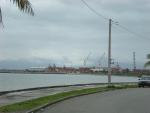 I dont aspire to be the mayor of Cap Haitian, but if I were, my first priority would be the creation of a citywide public works program to fix the roads, clean up the trash, and (re) beautify the city. To keep the trash off the streets, I would try to convince investors to build a recycling plant in the city. I would try to get the new airport constructed as soon as possible and persuade American Airlines to have direct flights. Cap Haitian has a boulevard that faces out onto the ocean but there is very little on it except for a store, a bar, a restaurant, a shuttered theater, and a whole lot of street kids. I would try to reinvigorate Cap Haitian's musical legacy. Both Tropicana and Septent were from Cap Haitian. I would do anything I could to get locals and members of the Diaspora to build clubs, bars, restaurants, and other places where music could be played. This would be good both for locals and one day, si dye vle, tourists. I would get the road to Labadee paved as soon as possible since the beaches are a major selling point. Why not a museum on the history of piracy and/or organized tours to Bois Cayman, the Citadel, Vertieres, etc? There are so many possibilities here but there has been so little action to make them a reality.
I dont aspire to be the mayor of Cap Haitian, but if I were, my first priority would be the creation of a citywide public works program to fix the roads, clean up the trash, and (re) beautify the city. To keep the trash off the streets, I would try to convince investors to build a recycling plant in the city. I would try to get the new airport constructed as soon as possible and persuade American Airlines to have direct flights. Cap Haitian has a boulevard that faces out onto the ocean but there is very little on it except for a store, a bar, a restaurant, a shuttered theater, and a whole lot of street kids. I would try to reinvigorate Cap Haitian's musical legacy. Both Tropicana and Septent were from Cap Haitian. I would do anything I could to get locals and members of the Diaspora to build clubs, bars, restaurants, and other places where music could be played. This would be good both for locals and one day, si dye vle, tourists. I would get the road to Labadee paved as soon as possible since the beaches are a major selling point. Why not a museum on the history of piracy and/or organized tours to Bois Cayman, the Citadel, Vertieres, etc? There are so many possibilities here but there has been so little action to make them a reality.
As I see again the many historical reminders of Haitian strength and tenacity, it give me hope for the future knowing that Haitians have succeeded against all odds in the past. This history, which is a legacy for all Haitians, can help the country to unite and give us the strength to recover and build a better Haiti.
Thanks for reading
Bryan
Add new comment